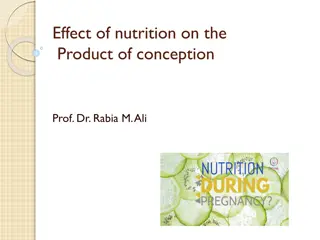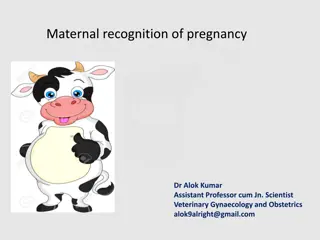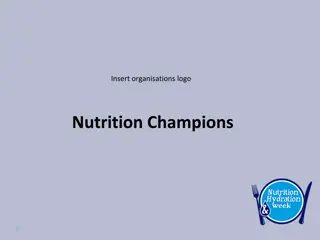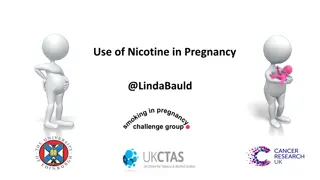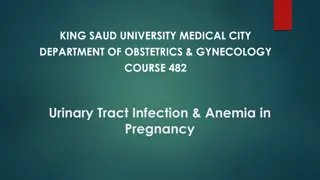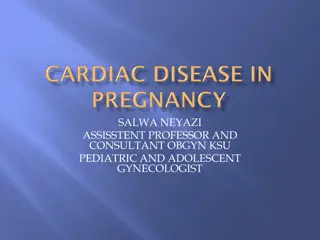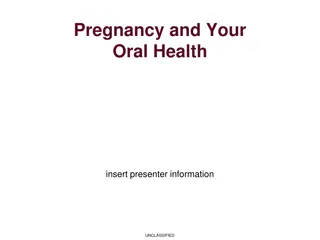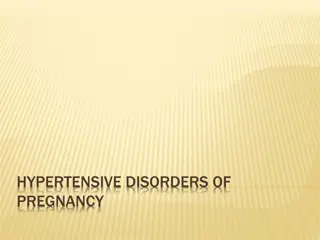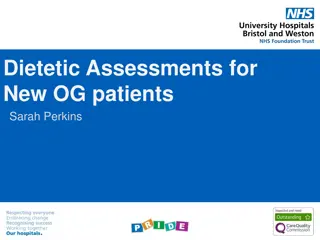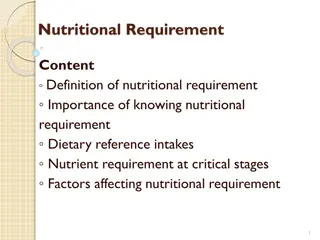Understanding Nutritional Requirements in Pregnancy by Aamena Zaidi
Adequate nutrition before and during pregnancy is crucial for long-term maternal and fetal health. Maternal health is influenced by genetic, social, and economic factors, impacting physiological adaptations for better nutrient utilization. Physiological changes in pregnancy include increased total plasma volume, blood volume expansion, altered levels of nutrients in blood, decreased taste sensitivity, enhanced nutrient absorption, and weight distribution changes. Increased weight gain during pregnancy correlates with higher birth weights and decreased low birth weight infants.
Download Presentation

Please find below an Image/Link to download the presentation.
The content on the website is provided AS IS for your information and personal use only. It may not be sold, licensed, or shared on other websites without obtaining consent from the author. Download presentation by click this link. If you encounter any issues during the download, it is possible that the publisher has removed the file from their server.
E N D
Presentation Transcript
NUTRITIONAL REQUIREMENTS IN PREGNANCY BY AAMENA ZAIDI Assistant Professor Department of Nutrition Science
Adequate nutrition before and during pregnancy has greater potential for a long-term health than it does at any other time. Maternal health is a complex, influenced by various genetic, social and economic factors, infections and environmental conditions, many of which may affect Physiological adaptations result in improved utilisation of nutrients either through increased absorption, decreased excretion or alternations in metabolism. the foetal growth.
PHYSIOLOGICAL CHANGES Total plasma volume in a non pregnant woman averages 2600 ml. By 34 weeks it is about 50 per cent greater than it was at conception.
Blood volume expands by 50 per cent resulting in a decrease in haemoglobin levels, blood glucose values and serum levels of albumin, other serum proteins and water- soluble vitamins. By contrast, scrum concentrations of fat soluble vitamins and other lipid fractions, such as triglycerides, cholesterol and free fatty acids increase.
There is a decreased ability to taste saltiness. Increased progesterone level relaxes the uterine muscle to allow expansion with foetal growth. Gastrointestinal motility diminishes, to allow for increased absorption of nutrients. This often results in constipation. During pregnancy appetite increases and nausea and vomiting may occur. Motility is diminished and intestinal secretion is reduced absorption of nutrients is enhanced.
Increased glomerular filtration rate. Increased amounts of a acids, glucose and water soluble vitamins may appear in the urine. The ability to excrete water is lowered and oedema in the legs and ankles is common and normal. Less than half of the total weight gain resides in the foetus, placenta and amniotic fluid, the remainder is found in maternal reproductive tissues, fluid, blood and maternal stores, a component composed largely of body fat blood volume produces a high
Increased weight gain during pregnancy is associated with increased birth weight and progressive decrease in the number of low birth weight infants. High oestrogen levels during pregnancy promote a gynecoid type of fat distribution.
ROLE OF PLACENTA Placenta forms a vital link between the mother and the growing baby. The placenta is the principal site of production for several hormones regulation of foetal growth and development of maternal support tissues. It is also involved for exchange of nutrients, oxygen and waste products responsible for
NUTRITIONAL REQUIREMENTS Under nutrition of the mother, preceding and during pregnancy affects the growing foetus in the womb. Increase in nutritional requirements is due to metabolic changes of pregnancy and the trition reserves of the mother.
ICMR Recommended Dietary Allowances for an Expectant Mother-2020 Nutrient Normal adult woman Pregnant Woman (for second and third trimester) ENERGY (KCal) Sedentary Worker 1660 +350 Moderate Worker 2130 +350 Heavy Worker 2720 +350 PROTEIN (gm) 46 +9.5 and +22 CALCIUM (mg) 1000 1000 IRON (mg) 29 27 VITAMIN A (micro gm) 840 900 ASCORBIC ACID (mg) 65 +15
ENERGY Energy needs during pregnancy increase because of the :- growth and physical activity of the foetus, growth of the placenta and maternal tissue, normal increase in maternal body size, and deposition of fat, additional work involved in carrying the weight of the foetus and extra maternal tissues. slow but steady rise in basal metabolic rate during pregnancy.
BMR increases by about 5 per cent during the first trimester and increases by about 12 per during the third trimester. The total weight gain during 9 months of pregnancy may range from 10-12 kg. Expert committee recommended an additional intak of 350 Kcal/day during the second and third trimester.
Hence ICMR recommended energy requirement of pregnant woman as follows: Sedentary Worker:1660+350=2010 Moderate worker:2130+350=2480 Heavy Worker:2720+350=3070
PROTEIN The normal protein requirement of an adult woman is 46 gm/day. ICMR (2020) prescribed an additional amount of 9.5g and 22gm for pregnant woman. Additional protein is essential for: rapid growth of the foetus enlargement of the uterus, mammary glands and placenta.
increase in maternal circulating blood volume. formation of amniotic fluid and storage reserves for labour, delivery and lactation. transfer of amino acids from the mother to foetus. Milk, meat, egg and cheese are complete proteins and of high biological value. A pregnant woman requires 600 ml of milk per day. Additional protein may be obtained from legumes and whole grains, nuts and oil seeds Pulse: Cereal intake ratio should be 1:5.
VISIBLE FAT AND ESSENTIAL FATTY ACIDS N-3 fatty acids are required for normal conception, growth and development of an embryo. To meet this, diets of pregnant women should contain 30 g of visible fat. Corn, cotton seed, safflower and soyabean oils are good sources of linoleic acid, alpha- linolenic acid is present not only in fish oils but also found in green leaf vegetables, flax seeds, rape seed, soyabean and walnuts.
CALCIUM Calcium requirement suggested by ICMR for a pregnant woman is 1000mg/day. To prevent 'osteomalacia' mother's diet should contain less of phytic acid, adequate amounts of vitamin D and sufficient amount of calcium. Dairy products are a primary source of calcium. Green leafy vegetables like agathi and gingelly seeds also contribute to calcium.
IRON Iron requirement of a pregnant woman is 27 mg/day. To avoid iron deficiency a woman should enter pregnancy with a store of at least 300 mg of iron. Liver, dried beans, dried fruits, green leafy vegetables, eggs, enriched cereals and iron fortified salt provide additional sources of iron.
IODINE ICMR recommends 220 g/day of iodne. Iodine deficiency in mother can lead to abortion, still births, congenital anomalies, increased perinatal mortality, cretinism and psychomotor defects.
ZINC Zinc deficienc during the antenatal period leads to adverse effects on the newborn including foetal morality, foetal malformations ad reduced intrauterine growth. Low zinc during pregnancy doubles the risk of low birth weight and risk of preterm delivery.
VITAMIN A Normal requirements of Vitamin A for an adult woman is 840 ug/day and during pregnancy it is increased to 900 ug/day. Liver, egg yolk, butter, dark green and yellow vegetables and fruits are good source of Vitamin A A daily supplementation of 6000 IU for about 12 weeks appears to improve serum vitamin A levels and correct vitamin A deficiency in the pregnant women. Improving vitamin A status of pregnant women reduces maternal mortality.
VITAMIN D Vitamin D is highly essential as it enhances the maternal calcium absorption. Its active form calcidol and calcitriol play an important role in calcium metabolism of the foetus. Maternal deficiency of vitamin D results in neonatal hypocalcaemia and hypoplasia. Excessive vitamin D complications such hypercalcaemia, calcium deposits in various vital organs and mental retardation in the infants can also atherosclerosis, result in as a
VITAMIN E Vitamin E has an important role to play in the reproductive process and reduces the number of spontaneous abortions and still births.
VITAMIN K Vitamin K is essential for synthesis of prothrombin that is necessary for normal coagulation of blood. It is highly essential for preventing neonatal haemorrhage
VITAMIN B1 The ICMR recommendations of thiamine RDA for an adult woman is: 1.4 mg for sedentary worker 1.7 mg for moderate worker 2.2 mg for heavy worker For a pregnant woman the requirement is 2 mg/day. The relationship between thiamine and caloric intake remains the same as normal adult during pregnancy i.e., for 1000 calories 0.5 mg of thiamine is required.
VITAMIN B2 The ICMR recommendations of riboflavin RDA for an adult woman is: 1.9 mg for sedentary worker 2.4 mg for moderate worker 3.1 mg for heavy worker In a pregnant woman the RDA is increased by 2.7 mg/day. For 1000 calorie intake, 0.6 mg of riboflavin is required.
VITAMIN B6 Normal requirement of pyridoxine per day in an adult woman is: 1.9 mg for sedentary worker 1.9 mg for moderate worker 2.4 mg for heavy worker ICMR suggested for pregnancy 2.3mg/day.
DIETARY FOLATE Normal adult woman requirement of folate is 220 g/day. ICMR recommendations during pregnancy are 570 g/day. Folic acid is needed for the synthesis of essential components of DNA and RNA which increase rapidly during increasing the requirements. Folic acid is essential for the development RBCs which increase as the mother's blood volume increases. growth thereby
The greatest significance of folic acid and its potential influence on pregnancy outcome is its role in preventing neural tube defects, such as spina bifida. In this condition there is a congenital defect in which the vertebral neural arches fail to close, so exposing the contents of the spinal canal posteriorly. Folic acid deficiency can lead to anencephaly- absence of brain. Folic acid deficiency also been implicated in pregnancy induced hypertension.
Green leafy vegetables like gogu leaves and tamarind leaves and legumes like moth bean, red gram, rajmah and soya beans are good sources of folic acid. Nuts (ground nuts), vegetables, (beet root, lady's finger, capsicum) and fruits (mango) also contribute to folic acid.
VITAMIN B12 Normal adult woman's requirement of vitamin B12 is 2.2 micro gm/day, and additional +0.25 micro gm/day is required during pregnancy. Vegan mothers have more chances of getting B12 deficiency as vitamin B12, is present in foods of animal origin.
VITAMIN C Normal requirement of Vitamin C per day in an adult woman is 840 mg/day. ICMR suggested for pregnancy 900 mg/day. .Low maternal intake of vitamin C is associated with premature rupture of foetal membranes and increased neonatal death rates. A few studies have suggested an association between low plasma levels of Vitamin C and pre-eclampsia.
RELATIONSHIP BETWEEN MATERNAL NUTRITION AND FOETAL NUTRITION Inadequate food intake and poor nutrient utilization I Maternal malnutrition I Reduced blood volume expansion I Inadequate increase in cardiac output Decreased blood and nutrient supply to the foetus I Reduced placental size I Reduced nutrient transfer I Foetal growth retardation
RELATIONSHIP BETWEEN MATERNAL NUTRITION AND FOETAL NUTRITION Nutritional deficiencies during the growth period in the womb and after birth tend to cause low weight and small size. Due to undernourishment of the mother the baby is at an increased risk of being premature with low birth weight and developmental irregularities
Intrauterine nutrition is highly important ir the growth of the central nervous system and kidneys of the foetus which mature during the Iater part of pregnancy. Intra uterine growth retardation can occur due to deficiency of energy, folic acid, vitamin A, vitamin B12 , ribolavin and iodine.
FOOD REQUIREMENTS For a pregnant woman whose diet has conformed to the 'Basic Five Food' pattern, it is merely a matter of emphasizing the more nutrient dense foods within each of the five food groups. Nutrient dense foods are those that give the most nutrients per calorie consumed.
Usually a daily diet containing 3 cups of milk, 2 servings of meat, fish, poultry, eggs, or a source of complete protein ,dark green leafy vegetables, citrus fruits will provide a foundation nutritionally adequate diet. Consumption of small and frequent at regular intervals are helpful.






